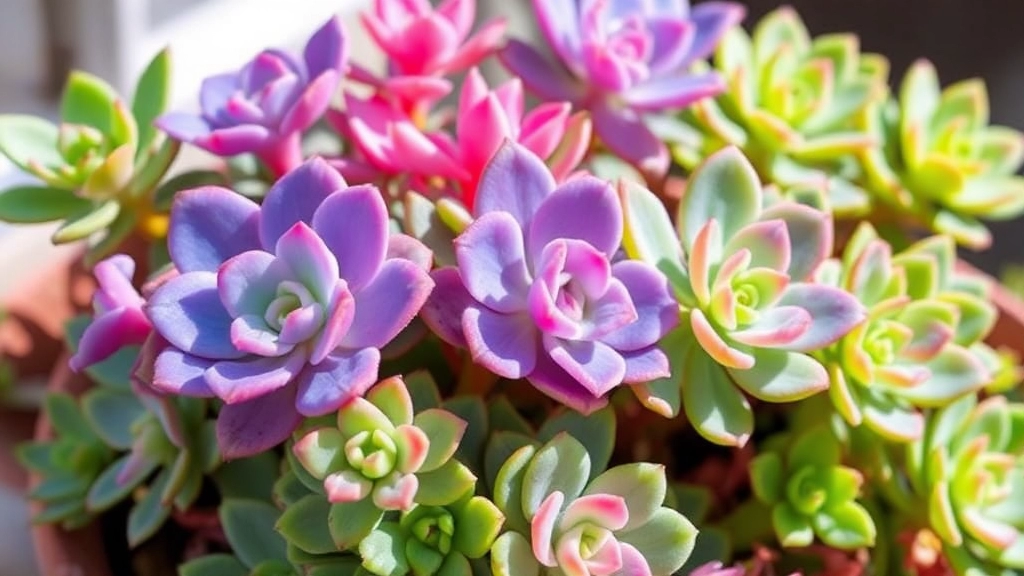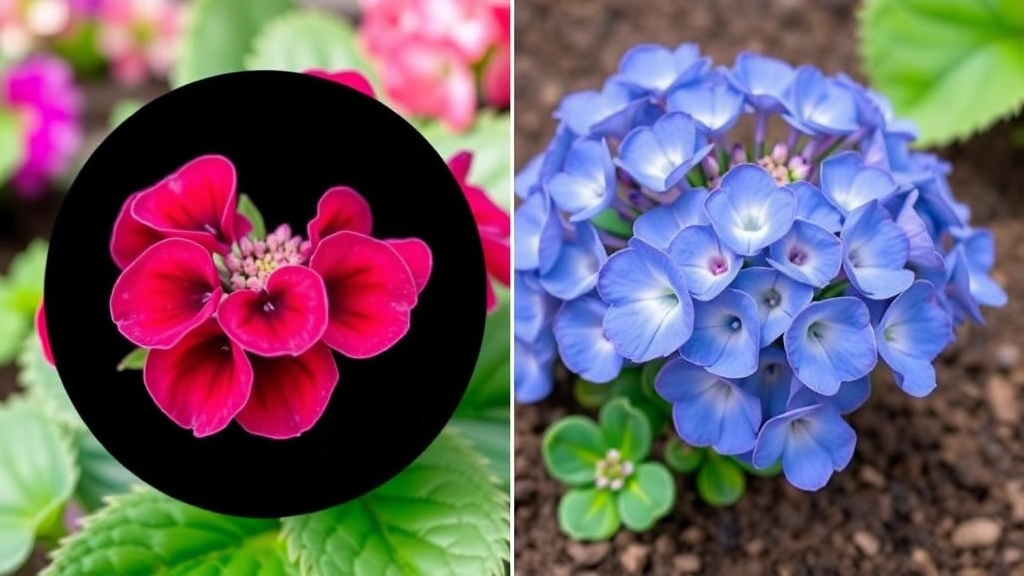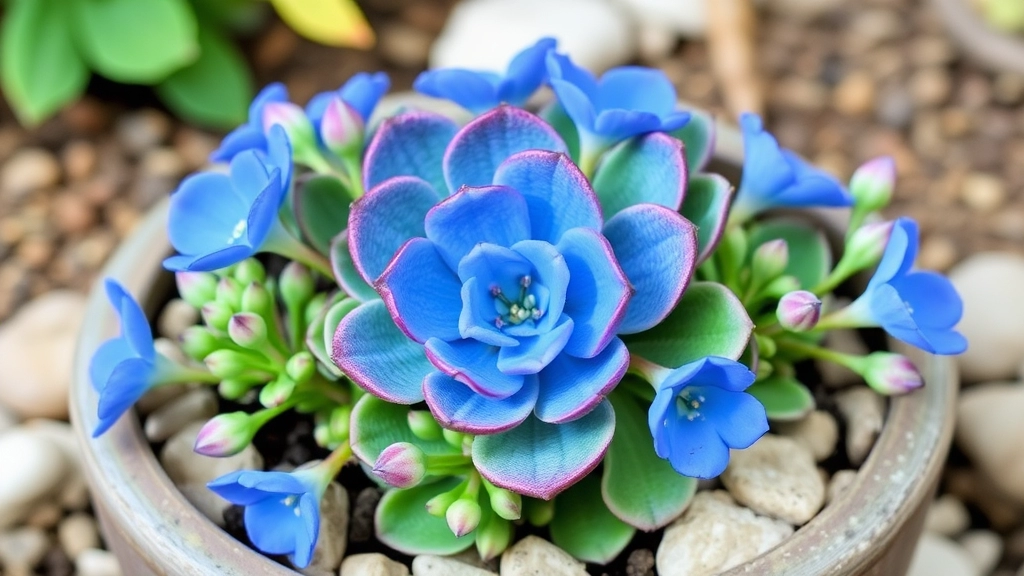Blue Kalanchoe Succulent
If you’re captivated by the unique charm of the Blue Kalanchoe Succulent, you’re not alone. This striking plant, known for its bluish-green foliage, is a favourite among plant enthusiasts and gardeners alike. Whether you’re looking to identify popular blue Kalanchoe varieties or seeking tips on how to care for them, you’ve come to the right place.
Caring for Blue Kalanchoe Succulents
Caring for Blue Kalanchoe Succulents is simpler than you might think. With the right light and temperature conditions, proper watering, and the best soil mixes, your succulent can thrive both indoors and outdoors. Ready to dive into the world of Blue Kalanchoe? Let’s explore everything you need to know to keep your plant healthy and vibrant.
When diving into the world of Blue Kalanchoe, you might wonder which varieties are the best fit for your collection.
These succulents are not only visually stunning but also bring a unique charm to any space.
– **Kalanchoe thyrsiflora**: Also known as the “Paddle Plant,” this variety features thick, paddle-shaped leaves with a bluish hue. It’s known for its striking rosettes and vibrant yellow flowers.
– **Kalanchoe luciae**: Commonly referred to as the “Flapjack Plant,” it showcases large, flat leaves that turn a beautiful shade of blue when exposed to sunlight. Its red edges add an extra pop.
– **Kalanchoe beharensis**: Known as the “Elephant Bush,” this variety has a more rugged appearance. Its thick, textured leaves have a blue tint, making it a unique addition to your collection.
– **Kalanchoe ‘Blue Moon’**: This hybrid is specifically bred for its stunning blue foliage. It’s compact, making it perfect for small spaces or indoor arrangements.
– **Kalanchoe ‘Blue Diamond’**: With its striking blue-grey leaves and vibrant pink flowers, this variety is a showstopper that can elevate any plant display.
Choosing the right Blue Kalanchoe variety can enhance your indoor or outdoor space significantly. For more detailed care tips, you might want to explore the [Kalanchoe Flapjack Varieties](https://planthq.org/kalanchoe-flapjack-varieties-types-care-and-tips/) and the [Complete Guide to Kalanchoe Plant Care](https://planthq.org/complete-guide-to-kalanchoe-plant-care/).
Light and Temperature Requirements for Blue Kalanchoe Succulents

So, you’ve got your eye on a Blue Kalanchoe, and you’re wondering how to keep it thriving.
One of the most crucial factors in their care is understanding their light and temperature needs.
These succulents are pretty laid-back but do have their preferences.
Light Requirements
Blue Kalanchoe loves bright, indirect sunlight.
Here’s what you need to know:
- Ideal Spot: A south or west-facing window is perfect.
- Direct Sunlight: Too much can scorch their leaves, so watch out!
- Low Light: They can survive in lower light, but you might miss out on those vibrant blooms.
Temperature Preferences
When it comes to temperature, Blue Kalanchoe likes it warm but not too hot.
- Ideal Range: Aim for 20-25°C (68-77°F) during the day.
- Nighttime Chill: They can tolerate cooler nights, down to about 10°C (50°F).
- Frost Alert: These beauties are not frost-tolerant, so bring them indoors if temperatures drop.
Watering Guidelines: How to Prevent Overwatering
One of the most common concerns for Kalanchoe enthusiasts is how to effectively manage watering. Overwatering can lead to root rot, a serious issue that can jeopardise your beautiful Blue Kalanchoe.
Key Watering Tips
- Check the Soil: Always check the soil moisture before watering. Stick your finger about an inch deep into the soil. If it feels dry, it’s time to water.
- Watering Frequency: In general, Blue Kalanchoe prefers to dry out between waterings. This often means watering every two to three weeks, but this can vary based on your environment.
- Watering Method: Water thoroughly until it drains from the bottom. Ensure that you empty any excess water from the saucer to prevent the roots from sitting in water.
- Seasonal Adjustments: During the growing season (spring and summer), you may need to water more frequently. In contrast, reduce watering in the dormant winter months.
- Signs of Overwatering: Keep an eye out for yellowing leaves or mushy stems. These are tell-tale signs that your Kalanchoe is receiving too much water. If you notice these symptoms, refer to our guide on how to address common issues.
Best Soil Mixes for Blue Kalanchoe Varieties

As we explore the essentials of Blue Kalanchoe care, the right soil mix is crucial for their health and growth. Many plant enthusiasts often wonder, “What type of soil do Blue Kalanchoe varieties thrive in?”
Ideal Soil Characteristics:
For Blue Kalanchoe, the best soil mix should be:
- Well-Draining: Succulents like Kalanchoe are prone to root rot if their roots sit in water.
- Lightweight: A lighter mix allows for better air circulation, which is vital for healthy root development.
- Nutrient-Rich: While succulents don’t need overly rich soil, a bit of organic matter can help them thrive.
Recommended Soil Mixes:
- Cactus Mix: Many garden centres offer pre-made cactus mixes that are perfect for Blue Kalanchoe.
- DIY Mix: You can easily create your own by combining:
- 50% potting soil
- 25% perlite
- 25% coarse sand
- Commercial Succulent Mixes: These are specifically designed for succulents and often contain the right balance of drainage and nutrients.
Tips for Soil Maintenance:
- Repotting: Consider repotting your Kalanchoe every couple of years to refresh the soil and ensure optimal growth.
- pH Level: Aim for a soil pH between 6.0 and 7.0, as this range supports healthy growth.
Propagation Techniques for Expanding Your Blue Kalanchoe Collection
Have you ever wondered how to multiply your Blue Kalanchoe collection without spending a fortune?
Propagation is a rewarding and straightforward process that allows you to grow new plants from existing ones. Here’s how you can do it effectively:
1. Leaf Cuttings
– **Select Healthy Leaves**: Choose plump, healthy leaves from your Blue Kalanchoe.
– **Cut and Dry**: Use a clean, sharp knife to cut the leaves. Allow them to dry for a few days until the cut end forms a callous.
– **Planting**: Place the dried cuttings in well-draining soil, burying them just enough to hold them upright.
– **Water Sparingly**: Mist the soil lightly and place the pot in bright, indirect light.
2. Stem Cuttings
– **Choose a Stem**: Find a healthy stem with several leaves.
– **Make a Clean Cut**: Cut the stem about 4-6 inches long, ensuring it has a few leaves attached.
– **Let it Callous**: Similar to leaf cuttings, let the cut end dry for a few days.
– **Plant and Water**: Insert the stem into well-draining soil and water lightly.
3. Offsets
– **Locate Offsets**: Look for small plants or offsets growing at the base of your Blue Kalanchoe.
– **Gently Remove**: Carefully detach them from the main plant, ensuring you get some roots.
– **Plant in Soil**: Place them in their own pots with suitable soil, and water lightly.
4. Seeds
– **Collect Seeds**: If your Blue Kalanchoe flowers, collect the seeds after they mature.
– **Sow**: Sprinkle the seeds on top of moist soil and cover lightly.
– **Keep Moist**: Mist regularly until they germinate, usually within a few weeks.
By following these simple propagation techniques, you can easily expand your Blue Kalanchoe collection and share them with friends or beautify your space. For more detailed guidance, check out our step-by-step guide on [how to propagate Kalanchoe in water](https://planthq.org/how-to-propagate-kalanchoe-in-water-stepbystep-guide/) or learn about the [complete care guide for Kalanchoe Chocolate Soldier](https://planthq.org/complete-care-guide-for-kalanchoe-chocolate-soldier/).
Common Issues and How to Avoid Them in Blue Kalanchoe Care

So, you’ve got your Blue Kalanchoe all set up, but maybe you’re starting to notice a few issues.
What’s going wrong?
Here are some common problems and how to sidestep them like a pro.
1. Overwatering Woes
One of the biggest culprits in Kalanchoe care is overwatering.
These beauties are succulents, which means they love to dry out a bit between drinks.
Tips to Avoid Overwatering:
- Check the Soil: Stick your finger in the soil; if it’s dry an inch down, it’s time for a drink.
- Use Well-Draining Pots: Make sure your pot has drainage holes. No one likes soggy feet!
- Water Sparingly: During the winter months, cut back on watering even more.
2. Pest Problems
Pests can be a real headache.
Mealybugs and aphids love to munch on Kalanchoe leaves.
How to Keep Pests at Bay:
- Regular Inspections: Check your plants weekly for any unwanted guests.
- Neem Oil Spray: A natural way to deter pests; just mix it with water and spray it on your plant.
- Isolate Infested Plants: If you find pests, move the affected plant away from others to prevent spreading.
3. Sunburnt Leaves
Too much direct sunlight can scorch those lovely blue leaves.
To Prevent Sunburn:
- Gradual Sun Exposure: If you’re moving your plant outdoors, do it slowly to help it acclimate.
- Filtered Light: Aim for bright, indirect light instead of harsh direct sunlight.
4. Leggy Growth
If your Kalanchoe starts reaching for the light, it might be a sign it’s not getting enough.
Fixing Leggy Growth:
- Move It Closer to a Light Source: Ensure it’s getting ample bright light.
- Rotate Your Plant: This helps it grow evenly on all sides.
5. Leaf Drop
Sudden leaf drop can be alarming.
This often happens due to stress from changes in environment or care routine.
To Minimize Leaf Drop:
- Keep Conditions Stable: Try to maintain consistent light, temperature, and watering habits.
- Avoid Shock: When repotting or moving, do it gently.
Decorative Uses for Blue Kalanchoe in Indoor and Outdoor Spaces
Are you looking for ways to enhance your living space with the vibrant hues of Blue Kalanchoe?
These stunning succulents are not just easy to care for; they also add a unique charm to both indoor and outdoor environments.
Indoor Decor
- Table Centerpieces:
- Place Blue Kalanchoe in decorative pots on your dining or coffee table.
- Their striking blue flowers can serve as a conversation starter.
- Windowsills:
- Position them on windowsills where they can soak up sunlight.
- This creates a lively atmosphere while providing a pop of colour.
- Shelving Units:
- Use Blue Kalanchoe as part of a shelf display.
- Mix them with books and other decorative items for an appealing aesthetic.
- Office Spaces:
- Add a small pot to your desk for a touch of nature.
- Studies suggest that plants can boost productivity and mood.
Outdoor Spaces
- Garden Borders:
- Plant Blue Kalanchoe along garden borders for a striking visual effect.
- Their unique colour contrasts beautifully with green foliage.
- Patio Planters:
- Use larger pots on patios or balconies to create a vibrant outdoor oasis.
- Group them with other succulents for a diverse display.
- Rock Gardens:
- Integrate Blue Kalanchoe into rock gardens for a natural look.
- Their drought resistance makes them ideal for such settings.
- Event Decor:
- Consider using Blue Kalanchoe in floral arrangements for events.
- Their long-lasting blooms are perfect for weddings and gatherings.
FAQs About Blue Kalanchoe Succulents
What kind of light does a Blue Kalanchoe need?
Blue Kalanchoe thrives in bright, indirect sunlight. A south or west-facing window is ideal. Be cautious of too much direct sunlight, as it can scorch their leaves.
What are the temperature preferences for Blue Kalanchoe?
These succulents prefer daytime temperatures between 20-25°C (68-77°F). They can tolerate cooler nights down to about 10°C (50°F) but are not frost-tolerant.
What type of soil is best for Blue Kalanchoe?
Blue Kalanchoe thrives in well-draining, lightweight, and slightly nutrient-rich soil. Cactus mixes or a DIY mix of 50% potting soil, 25% perlite, and 25% coarse sand are recommended.
How often should I water my Blue Kalanchoe?
Water your Blue Kalanchoe when the soil is dry an inch down. Overwatering is a common issue, so ensure the pot has drainage holes and reduce watering during winter months.
How can I prevent pests on my Blue Kalanchoe?
Regularly inspect your plants for pests like mealybugs and aphids. Use neem oil spray as a natural deterrent and isolate any infested plants to prevent spreading.
What should I do if my Blue Kalanchoe gets sunburnt?
To prevent sunburn, gradually acclimate your plant to outdoor conditions and aim for bright, indirect light rather than harsh direct sunlight.
Why is my Blue Kalanchoe growing leggy?
Leggy growth usually indicates insufficient light. Move your plant closer to a light source and rotate it regularly to ensure even growth.
What causes sudden leaf drop in Blue Kalanchoe?
Sudden leaf drop is often due to stress from changes in environment or care routine. Maintain consistent light, temperature, and watering habits, and handle the plant gently when repotting or moving.
How often should I repot my Blue Kalanchoe?
Repot your Blue Kalanchoe every couple of years to refresh the soil and ensure optimal growth. Aim for a soil pH between 6.0 and 7.0.
Can Blue Kalanchoe survive in low light conditions?
While Blue Kalanchoe can survive in lower light, it may not produce vibrant blooms. Bright, indirect light is ideal for the best growth and flowering.
References
-
Gardening Know How: Kalanchoe Plant Care
-
The Spruce: How to Grow and Care for Kalanchoe
-
Old Farmer’s Almanac: Kalanchoe
